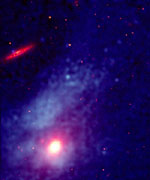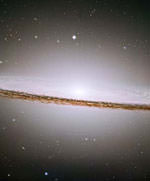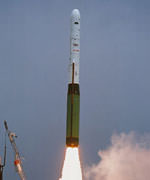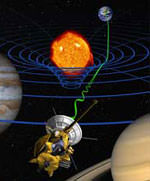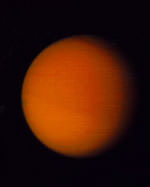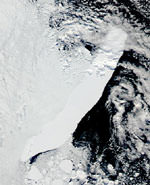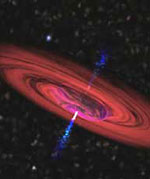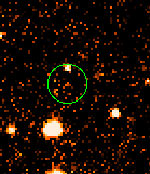
Image credit: Lowell Observatory
Asteroid 2003 SQ222 whizzed by the Earth last week, missing us by only 88,000 kilometres. The rock wasn’t large, only 3 to 6 metres across, but if it had hit the Earth it probably wouldn’t have caused damage as would burn up in the atmosphere. The asteroid was discovered by the Lowell Observatory and several amateur astronomers who collaborated to track its motion as it flew away from the Earth – unfortunately, they didn’t notice it until it had already passed us. Objects of this size do strike the Earth about once a year, and create a spectacular fireball in the sky for anyone lucky enough to spot it.
A small asteroid, perhaps 3 to 6 meters in diameter?the size of a room or house?came within 88,000 km of Earth late on Friday, September 27. Less than a quarter of the distance to the Moon, this is the closest well-documented Earth encounter of an asteroid that has not struck our atmosphere.
?In a good month, we find five to 10 near-Earth asteroids, but usually, the ones we discover are as big as mountains, or at least football stadiums, so this one was unique for us,? said Edward Bowell, Director of Lowell Observatory?s Near-Earth-Object Search (LONEOS).
Known as 2003 SQ222, the asteroid was imaged a few hours after close approach by Michael Van Ness, a graduate student at Northern Arizona University, Flagstaff.
LONEOS is one of five teams funded by NASA?s Near Earth Objects Observations program to look for asteroids and comets that could come close to or strike our planet. LONEOS is the third leading discoverer of asteroids.
The first images of SQ222 were made on a series of CCD-camera frames (charge-coupled device) taken for Minor Planet Research, an organization collaborating with LONEOS on a project with an aim of having high school students make asteroid discoveries at the Challenger Learning Center in Peoria, Arizona. Robert Cash, of MPR, used automatic moving-object detection software to find three trailed images of an object moving at 20 degrees per day, almost twice as fast as the Moon, across the sky. Cash relayed his discovery back to Lowell Observatory and to the international clearinghouse for asteroid and comet observations, the Minor Planet Center, in Cambridge Massachusetts.
Predicted positions were posted on the MPC?s Near-Earth Object Confirmation Page so observers worldwide could follow the object.
Meanwhile, Bowell noticed that it was possible to compute a fairly reliable orbit. ?The orbit showed clearly that SQ222 had passed within a quarter of the Moon?s distance to the Earth, some 11 hours before being discovered,? said Bowell. ?So, I e-mailed our results to the Minor Planet Mailing List, to which hundreds of amateur and professional astronomers subscribe, with a request for further observations.?
Brian Skiff, LONEOS? chief observer, acquired fresh CCD frames on September 29, but the LONEOS team was unable to locate the asteroid?s images. Once again, Bob Cash found the by then very faint images of the asteroid after visually searching the frames for more than three hours in the wee hours of September 30th. You can view two sequences of LONEOS images of SQ222.
Independently, British amateur astronomer Peter Birtwhistle, using a 30-cm telescope west of London, was able to image the asteroid. ?It is remarkable that Birtwhistle was able to detect the asteroid using such a small telescope,? said Bowell. ?He did so by tracking the motion of the asteroid and by aligning and co-adding (or stacking) the frames to bring out the faint asteroid images.?
?The essential rapid teamwork between Lowell Observatory and keen amateur astronomers made it possible to confirm and image this fast-moving, small asteroid as it shot past us,? said Bowell.
SQ222?s known brightness and distance allow calculation of its size. Most asteroids have either coal-black surfaces or are about four times more reflective. Bowell estimates the asteroid to be just 3 to 6 meters in diameter, most likely making it the smallest asteroid for which we have a reliable orbit. (Smaller and closer asteroids have been seen in space, especially by the Spacewatch team at the University of Arizona, but it has not been possible to follow them long enough to secure good orbits.)
Perhaps the final detection of SQ222 was made by British astronomer Alan Fitzsimmons (Queen?s University Belfast) on October 2. Fitzsimmons, working through thin cloud, managed to detect the asteroid using the 2.5-m Isaac Newton Telescope at La Palma in the Canary Islands. By then, SQ222, receding rapidly from Earth, was about 100 times fainter than at discovery.
After Fitzsimmons? observations, the orbit of SQ222 was good enough to compute a reliable value of what astronomers call the minimum orbital intersection distance, (MOID).
This is the minimum distance between the orbit of the asteroid and that of the Earth. Bowell calculated the MOID to be a little over 4 Earth radii (about 27,000 km).
?This distance is, roughly speaking, the very closest the asteroid could have come to the center of the Earth during its fly-by,? said Bowell. ?Therefore, SQ222 could not possibly have struck the Earth.? Even if it could have, it would have exploded harmlessly in the upper atmosphere, with an energy comparable to that of a small atomic bomb, as friction with the air vaporized its surface, added Bowell.
?Objects the size of SQ222 actually do burn up in Earth?s atmosphere every year or so, producing a spectacular light show,? said Bowell.
In what is most likely a coincidence, an intense shower of meteorites was reported in India about 10 hours before SQ222?s closest approach to Earth. Could the asteroid and the meteorites be fragments of a larger asteroid that was broken apart by a collision with another asteroid or by tidal disruption during a previous very close Earth approach? It seems very unlikely, but work is ongoing to test the plausibility of the idea.
Will SQ222 make another close pass by Earth? It is hard to say, as the orbit is not accurate enough to make reliable predictions for more than a few years into the future. Certainly, there seems no possibility of it returning within the next decade. Also, SQ222 will be too faint to see in the foreseeable future, even using the most powerful telescopes.
Original Source: Lowell News Release
